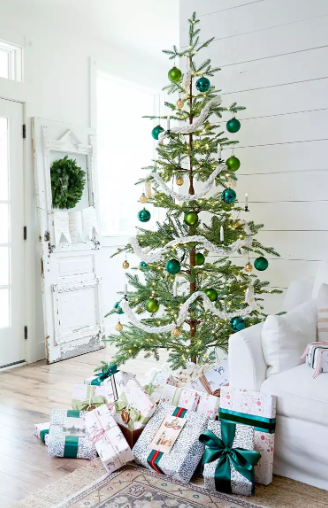If you don’t like the mess of a real evergreen, or if allergies prevent you from having a live tree, try an artificial Christmas tree for your holiday decor.
Christmas trees are a classic element in holiday decorating and for the best selection of artificial trees, many turn to KingofChristmas.com. However, some people don’t like the fuss and mess of a live tree, while others have allergies that preclude them from displaying a real evergreen. Buying an artificial Christmas tree might save you the hassle of heading out to the tree farm on a cold day to choose a real tree (cue the iconic Christmas Vacation scene), but there are a few factors to consider before you make a selection.
Why Choose an Artificial Christmas Tree?
An artificial tree can also be a more eco-friendly and cost-effective option than chopping down a live fir. If you’re wondering how to choose an artificial Christmas tree, consider the size, accents, and height. To help you find the right tree for your home, we talked to Jennifer Derry, chief merchandising officer at Balsam Hill, to learn the must-know tips about selecting artificial Christmas trees.
Use these helpful ideas as a guide when purchasing your fake trees for the holidays. We’ll show you how to choose the most realistic artificial Christmas tree with lights or without.
Investing in an artificial Christmas tree, particularly a high-quality one, is worthwhile. If you’re open to alternatives to live trees, artificial options offer numerous advantages. They maintain their appearance season after season, remaining perpetually green.
According to Derry, selecting an artificial tree doesn’t mean sacrificing the authenticity of a real tree. With a plethora of lifelike options available, along with various fragrance choices for that fresh-cut aroma, your holiday guests won’t notice the difference.
Moreover, Derry highlights additional benefits of artificial trees: they’re hypoallergenic, flame-resistant, require no daily watering, and when utilized for at least five years, they prove to be the most environmentally friendly and cost-effective option.
Choosing the Height and Width of an Artificial Christmas Tree
Most artificial Christmas trees come in three widths: full, slim, or pencil. They also vary in height, starting from tabletop sizes and increasing typically in half-foot increments up to about 12 feet. To ensure the best fit for your space, measure the area where you intend to place the tree and allow ample room for decorating around it.
Derry advises leaving at least 6 inches of clearance from the ceiling and wall to accommodate any future tree toppers. She suggests opting for a full-sized tree if space allows, and a narrower or slim tree for more confined areas. Additionally, for tight spaces, a flat-back Christmas tree offers the classic holiday aesthetic while sitting closer to the wall.
Lights or No Lights?
Consider the value of a pre-lit tree versus the added expense. Although pre-lit trees typically cost more, they save time and hassle during decoration. You can avoid the chore of untangling light strands when retrieving holiday decorations from storage.
If you opt for a pre-lit tree, you’ll need to decide between incandescent or LED lights. According to Derry, LED lights are more energy-efficient and produce less heat, albeit at a higher cost compared to incandescent bulbs.
Choosing the Material of an Artificial Tree
Artificial trees mimic various types of real trees, offering a wide array of options. Derry emphasizes the importance of personal preference in selecting the right tree. When shopping online, she recommends requesting branch samples, especially for pricier trees intended for long-term use.
Artificial trees feature two types of branches: hinged or hook-in. While hinged trees are easier to assemble, hook-in trees offer cost savings but require more time to set up. Additionally, artificial trees are made from PVC or PE plastic, each providing a different appearance. PE trees, with fabricated needles and branches, offer a more realistic look compared to PVC trees.
Tinsel, Feather, and Other Artificial Trees
Beyond traditional evergreen designs, artificial trees cater to various decorating preferences. Tinsel and feather trees, often in white, silver, or gold, serve as alternatives, with some available in full sizes. These options offer versatility for different spaces and decorative styles.
Editor’s Tip: Evaluate the density and sturdiness of branches when purchasing a fake tree, especially if you plan to hang numerous ornaments.
Choosing Artificial Tree Accents
Pre-lit trees streamline setup and cleanup, though they may cost more initially. Look for pre-lit trees labeled “continuous on” or with burn-out protection to ensure uninterrupted lighting. Flocked trees, dusted with snow or glitter, and those adorned with natural accents like pinecones offer additional decorative choices.
Additional Considerations When Choosing Artificial Trees
Price varies widely depending on quality and additional features. Custom options are available but come at a higher cost. Ensure your tree includes necessary accessories like stands, and check for warranties. Both artificial and live trees can complement various holiday styles, providing flexibility in decorating options.



